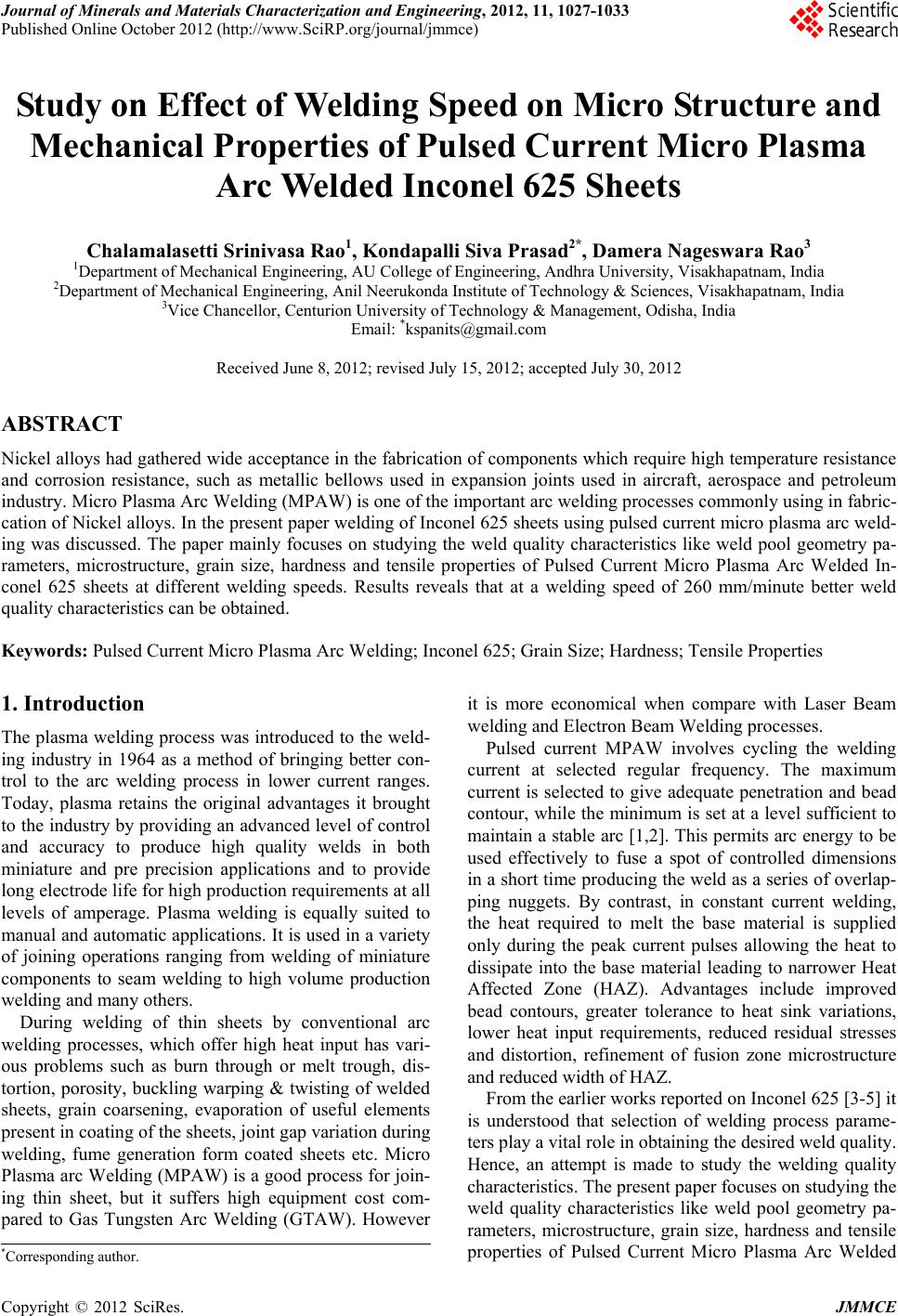
Journal of Minerals and Materials Characterization and Engineering, 2012, 11, 1027-1033
Published Online October 2012 (http://www.SciRP.org/journal/jmmce)
Study on Effect of Welding Speed on Micro Structure and
Mechanical Properties of Pulsed Current Micro Plasma
Arc Welded Inconel 625 Sheets
Chalamalasetti Srinivasa Rao1, Kondapalli Siva Prasad2*, Damera Nageswara Rao3
1Department of Mechanical Engineering, AU College of Engineering, Andhra University, Visakhapatnam, India
2Department of Mechanical Engineering, Anil Neerukonda Institute of Technology & Sciences, Visakhapatnam, India
3Vice Chancellor, Centurion University of Technology & Management, Odisha, India
Email: *kspanits@gmail.com
Received June 8, 2012; revised July 15, 2012; accepted July 30, 2012
ABSTRACT
Nickel alloys had gathered wide acceptance in the fabrication of components which require high temperature resistance
and corrosion resistance, such as metallic bellows used in expansion joints used in aircraft, aerospace and petroleum
industry. Micro Plasma Arc Welding (MPAW) is one of the important arc welding processes commonly using in fabric-
cation of Nickel alloys. In the present paper welding of Inconel 625 sheets using pulsed current micro plasma arc weld-
ing was discussed. The paper mainly focuses on studying the weld quality characteristics like weld pool geometry pa-
rameters, microstructure, grain size, hardness and tensile properties of Pulsed Current Micro Plasma Arc Welded In-
conel 625 sheets at different welding speeds. Results reveals that at a welding speed of 260 mm/minute better weld
quality characteristics can be obtained.
Keywords: Pulsed Current Micro Plasma Arc Welding; Inconel 625; Grain Size; Hardness; Tensile Properties
1. Introduction
The plasma welding process was introduced to the weld-
ing industry in 1964 as a method of bringing better con-
trol to the arc welding process in lower current ranges.
Today, plasma retains the original advantages it brought
to the industry by providing an advanced level of control
and accuracy to produce high quality welds in both
miniature and pre precision applications and to provide
long electrode life for high production requirements at all
levels of amperage. Plasma welding is equally suited to
manual and automatic applicatio ns. It is used in a variety
of joining operations ranging from welding of miniature
components to seam welding to high volume production
welding and many others.
During welding of thin sheets by conventional arc
welding processes, which offer high heat input has vari-
ous problems such as burn through or melt trough, dis-
tortion, porosity, buckling warping & twisting of welded
sheets, grain coarsening, evaporation of useful elements
present in coating of the sheets, joint gap variation during
welding, fume generation form coated sheets etc. Micro
Plasma arc Welding (MPAW) is a good process for join-
ing thin sheet, but it suffers high equipment cost com-
pared to Gas Tungsten Arc Welding (GTAW). However
it is more economical when compare with Laser Beam
welding and Electron Beam Welding processes.
Pulsed current MPAW involves cycling the welding
current at selected regular frequency. The maximum
current is selected to give adequate penetration and bead
contour, while the minimum is set at a level sufficient to
maintain a stable arc [1,2]. This permits arc energy to be
used effectively to fuse a spot of controlled dimensions
in a short time produ cing the weld as a series of overlap-
ping nuggets. By contrast, in constant current welding,
the heat required to melt the base material is supplied
only during the peak current pulses allowing the heat to
dissipate into the base material leading to narrower Heat
Affected Zone (HAZ). Advantages include improved
bead contours, greater tolerance to heat sink variations,
lower heat input requirements, reduced residual stresses
and distortion, refinement of fusion zone microstructure
and reduced width of HAZ.
From the earlier works reported on In conel 62 5 [3-5] it
is understood that selection of welding process parame-
ters play a vital role in obtaining the d esired weld quality.
Hence, an attempt is made to study the welding quality
characteristics. The present paper focuses on studying th e
weld quality characteristics like weld pool geometry pa-
rameters, microstructure, grain size, hardness and tensile
properties of Pulsed Current Micro Plasma Arc Welded
*Corresponding author.
Copyright © 2012 SciRes. JMMCE